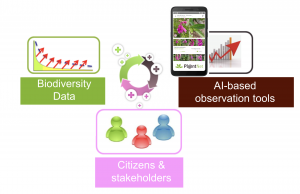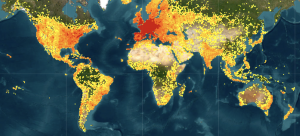Pl@ntNet is a citizen science platform that uses artificial intelligence (AI) to facilitate the identification and inventory of plant species. It is one of the world’s largest biodiversity observatories, with several million contributors in over 200 countries.
The Pl@ntNet application, available in web and smartphone versions (Android, iOS), lets you identify tens of thousands of plant species simply by taking a photo of them.
 Pl@ntNet is based on a cooperative learning principle. Users who have created an account can share their observations, which can then be reviewed by the community and used by the AI to teach it to recognize plants. It is possible, for example, to confirm the name of a species, or to suggest another determination if you know a little about botany. Only observations that achieve a sufficient degree of confidence are then added to the public database and used to train the AI.
Pl@ntNet is based on a cooperative learning principle. Users who have created an account can share their observations, which can then be reviewed by the community and used by the AI to teach it to recognize plants. It is possible, for example, to confirm the name of a species, or to suggest another determination if you know a little about botany. Only observations that achieve a sufficient degree of confidence are then added to the public database and used to train the AI.
Not all users carry the same weight in these review mechanisms. The most expert users can have up to 100 times more weight than novices!
In order to take into account new observations and revisions made by the community, Pl@ntNet’s AI is regularly re-trained. This is generally done on a monthly basis (rather than daily, for example) to limit energy consumption and carbon emissions.

The tool is thus co-constructed by and for citizens. The most qualified contribute the most expert knowledge (by contributing and reviewing observations), while the least qualified benefit from this knowledge through the use of the Pl@ntNet application.
Thanks to everyone involved, Pl@ntNet has collected over a billion plant images (see statistics)! Only a small proportion, however, is actually shared with researchers worldwide (via open biodiversity data portals such as GBIF). An important element is the presence of a GPS coordinate. This information is crucial for mapping species. So don’t forget to share your geo-location if you want to contribute to the citizen science project. There are also image quality filters that will reject images that are too blurry, too cluttered or that don’t contain enough information to identify the species. So be sure to zoom in on the various organs (by taking several photos) and focus! Finally, only those observations for which there is very little doubt about the identification will be shared.
 That’s tens of millions of observations! This makes Pl@ntNet one of the biggest contributors to the GBIF international database. These data can be easily explored and downloaded via the GBIF portal. You can even consult the hundreds of scientific publications that make use of Pl@ntNet data, on a wide range of issues such as biodiversity conservation, agro-ecology or the impact of climate change.
That’s tens of millions of observations! This makes Pl@ntNet one of the biggest contributors to the GBIF international database. These data can be easily explored and downloaded via the GBIF portal. You can even consult the hundreds of scientific publications that make use of Pl@ntNet data, on a wide range of issues such as biodiversity conservation, agro-ecology or the impact of climate change.

This project was provided with computer and storage resources by GENCI at IDRIS thanks to the grant 2023- A0151011389 on the supercomputer Jean Zay’s the A100 partition.
